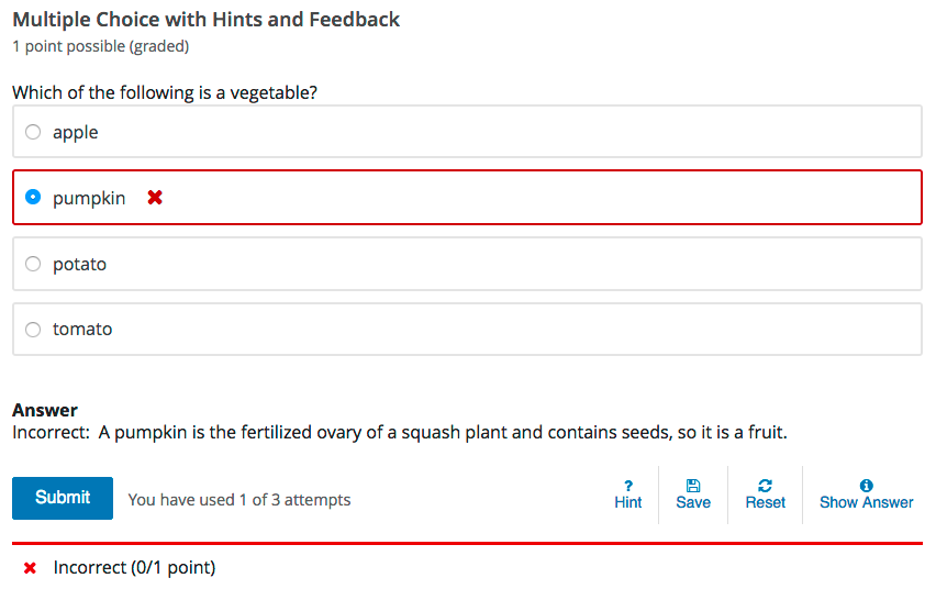Working with Problems and Tools Component
Common Problem Types
When you select any of the common problem types in Studio the simple editor opens.
- If you choose the Blank Common Problem option, the editor opens without providing a template or example for you to follow You can begin to add text and markdown for required and optional problem elements immediately.
- If you choose one of the following problem types, a template appears in the editor with guidance for adding all of that problem type’s required elements, as well as several optional elements.
Problem Type | Description | Support |
|---|---|---|
Checkbox Problem | In checkbox problems, learners select one or more options from a list of possible answers. To answer the problem correctly, a learner must select all of the options that are correct answers, and none of the incorrect options. | Full support; mobile-ready |
| Dropdown Problem | In dropdown problems, learners choose one answer from a set of possible answers, which are presented in a dropdown list after the learner selects the dropdown arrow. | Full support; mobile-ready |
| Multiple Choice Problem | In multiple-choice problems, learners select one answer from a set of possible answers, which are visible directly below the question. | Full support; mobile-ready |
| Numerical Input Problem | In numerical input problems, learners enter numbers or specific and relatively simple mathematical expressions to answer a question. These problems allow only integers and a few select constants. You can specify a margin of error, and you can specify a correct answer either explicitly or by using a Python script. | Full support; mobile-ready |
| Text Input Problem | In-text input problems, learners enter text into a response field. The response can include numbers, letters, and special characters such as punctuation marks. | Full support; mobile-ready |
Adding a Multiple Choice Problem
You add multiple-choice problems in Studio by selecting the Problem component type and then using the simple editor to specify the prompt and the answer options.
When you add a multiple-choice problem, you can choose one of these templates.
Multiple Choice
Multiple Choice with Hints and Feedback
These templates include the Markdown formatting that you use in the simple editor to add a problem without, or with, hints and feedback.
To use the simple editor to add a problem, follow these steps.
- In the unit where you want to create the problem, under Add New Component select Problem.
- From the list of Common Problem Types, select the type of problem you want to add. Studio adds a template for the problem to the unit.
- Click Edit. The simple editor opens to a template that shows the Markdown formatting that you use for this problem type.
- Replace the guidance provided by the template to add your text for the question or prompt, answer options, explanation, and so on.
- Click Settings to provide an identifying Display Name and define settings for the problem.
- Click Save.
Adding Feedback to a Multiple Choice Problem
You can add feedback that displays to learners after they submit an answer.
You create problems with feedback and hints in Studio. Templates with feedback and hints configured are available to make creating your problems easier.
While editing a unit, in the Add New Component panel, select Problem. In the list that opens, select Common Problem Types. Templates for problems with feedback and hints are listed.
Add the problem type you need to the unit, then edit the component. The exact syntax you use to configure hints and feedback depends on the problem type.
For example, the following multiple-choice problem provides feedback in response to the selected option when the learner selects Submit. In this case, feedback is given for an incorrect answer.

Additional Tools
This table lists the fully or provisionally supported additional tools that you can add to your course. If you want to use these tools please contact the EdTech team.
| Type | Descriptipn | Support |
|---|---|---|
Calculator Tool | Learners can enter input that includes Greek letters, trigonometric functions, and scientific or e notation in addition to common operators. The calculator tool is available for every course through the course advanced settings. When the calculator tool is enabled, it appears on every unit page. | Provisional support |
Google Calendar Tool | Learners see a Google calendar embedded in your course. You can use a Google calendar to share quiz dates, office hours, or other schedules of interest to learners. | Provisional support |
Google Drive Files Tool | Learners see a Google Drive file, such as a document, spreadsheet, or image, embedded in your course. | Provisional support |
Iframe Tool | With the iframe tool, you can integrate ungraded exercises and tools from any Internet site into an HTML component in your course. | Provisional support |
Peer Instruction Tool | This type of exercise offers the experience of the Peer Instruction learning system within your online course. | Full support |
Poll Tool | You can include polls in your course to gather learners’ opinions on various questions. You can use the Poll Tool in Studio. | Full support |
Survey Tool | You can include surveys in your course to collect learner responses to multiple questions. | Full support |
Word Cloud Tool | Word clouds arrange text that learners enter in response to a question into a colorful graphic. | Provisional support |
| Audio | Learners see an audio file | Full support |
This tool provides an easy way to embed a PDF | Full support | |
In Video Quiz | This tool allows for quizzes to be displayed to users inside of videos at specific time points. | Full support |
